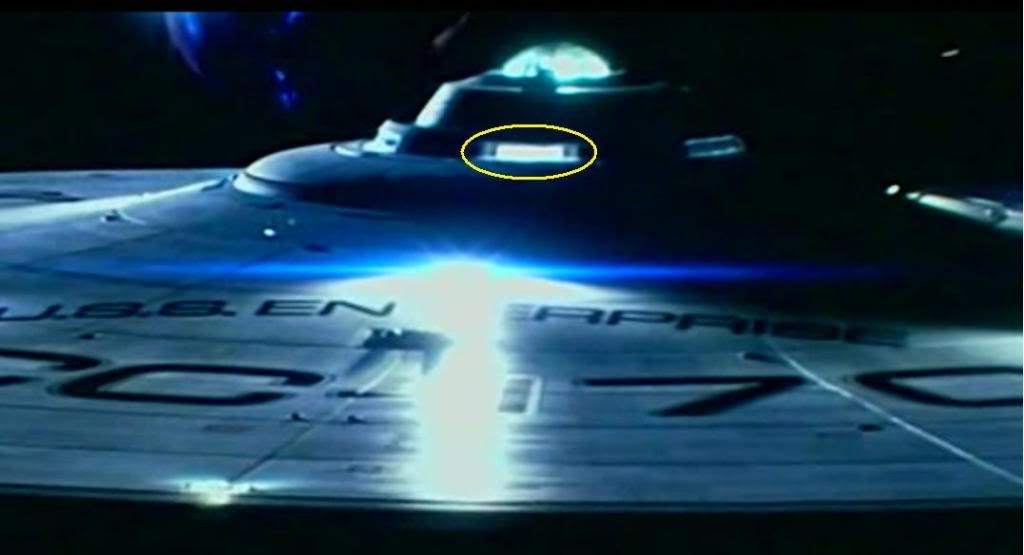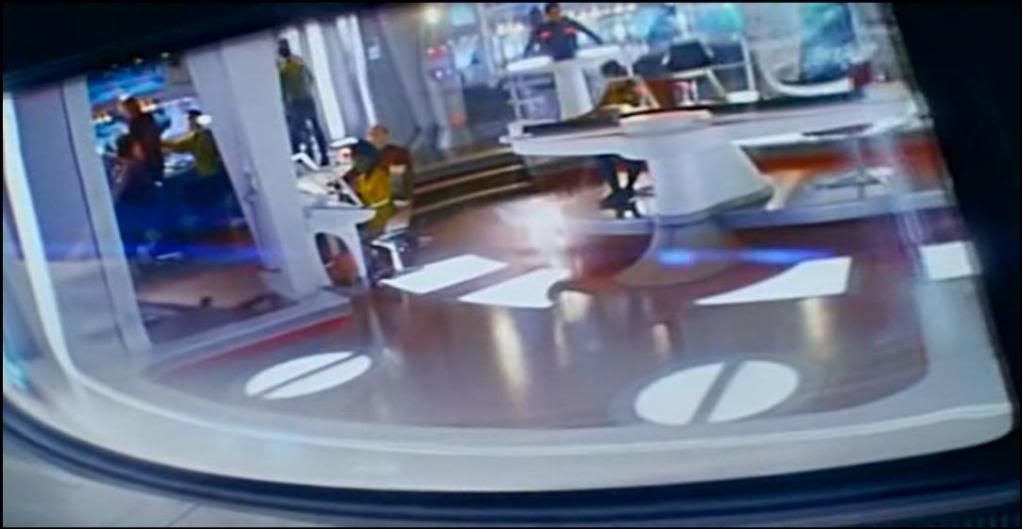Examining Schneider's argument in detail:
So what can we make of the supersized Enterprise? Do we have to believe what the official sources keep telling us now that there are scenes in the movie (that we would otherwise ignore) and more evidence in the form of scaled down external features?
No, we believe the visual evidence of the movie.
There are many reasons why I still maintain a size of some 300m for the new Enterprise:
As you wish...
* The sheer size of the new Enterprise is ludicrous. Had it been a fan design submitted to the JoAT, I would have declined it right away as an übership, unless the designer had agreed to modify the size to something more reasonable. At 725m length the Enterprise would be 2.5 times as long as the original Enterprise, and it would have as much as 15.8 times its volume! The alternate ship dwarfs any known Starfleet vessel of the Prime Universe, including the biggest starship classes of the 24th century. Sure, there is no rule that vessels always have to grow in size. But the leap to 15.8 times as large vessels in this new universe is a stretch by any means, especially if we consider that many things (such as the crew) are still the same in spite of the huge historical and technological differences.
Appeal to Incredulity Fallacy, and one turning on the wholly unfounded assumption that a rebooted
Star Trek must conform in all measures and aspects to it's parent series. That is not at all a given, never has been, and it was patently absurd to ever expect it to be so.
* The proportions of the saucer, neck, engineering hull and nacelles are somewhat different than on either the TOS and the TMP Enterprise, but overall still similar enough to put it into the same size range. In contrast, the designs of the much larger Enterprise-C (Ambassador class) and Enterprise-D (Galaxy) are visibly more compact, as we would expect from bigger ships because of the scaling issue. The big Enterprise-E (Sovereign class) is less compact again, but with its more streamlined hull the design takes a still different direction. If we don't pay attention to the small details such as the window sizes, everything about the new Enterprise looks like on a small (300m) ship, but we are supposed to believe that it is about the same order of size (volume-wise) as the Galaxy class!
The fact that every other object to which this ship compares as well as pixel measurements confirms the evident visual evidence is not dependent upon a fan's expectations for how a large-scale vessel is supposed to look. Indeed, this argument seems to make no cogent point whatsoever. Especially as it is quite apparent that the reboot movie was never made to conform to the measures and styles of either the parent series or it's direct sequels.
* While their sizes are subject to vary considerably between different ship classes of different eras, we would not expect all kinds of mid-sized and well-recognizable details such as phasers, thrusters, impulse engines, deflector dish, shuttlebay doors or bridge dome to change their sizes almost proportionally with the rest of the ship. This, however, is the case on the "Star Trek XI" Enterprise. Even if it could make sense technically, the proportional upsizing of almost every feature goes against the notion that it is intended to be bigger. The upscaled design would have to establish *some* substantial visual difference, but it doesn't.
Why? Certainly, the impulse engines and deflector dish would have to be of sufficient structural volume to adequately fulfill their functions for such a large spaceframe, and again this argument derives from a personal expectation of what a large ship is "supposed" to look like.
* There are two rows of windows in the saucer edge, whose arrangement is almost exactly as on the Probert Enterprise refit. Even the two darker stripes around the edge are almost the same. Actually, this detail was the ultimate reason for me to assume that the saucer has to be the same size, which made the new ship overall just a bit shorter than the TMP version. If the actual "Star Trek XI" Enterprise were more than twice as long, then the window arrangement in the saucer would be an incredibly stupid coincidence. It is already little useful to scale up hull designs as a whole. But the assumption that the windows would be still the same, leaving the new deck in between (the one behind the stripe) without windows, is simply ridiculous.
Why? What rule of design dictates that there
must be viewports for every deck on the ship or that they must conform to a particular size range in proportion to the decks they're located on? That there really is no reason to have viewports on a spaceship
at all is another issue for another discussion perhaps but there is nothing really prohibiting huge picture-viewports on such a large vessel from a design standpoint unless they would constitute an unacceptably hazardous series of weak-points in the hull.
Yes, it is just a detail, but the details are crucial to create an impression of the size of the ship.
Because a hangar deck with twin storage levels for a small fleet of 15-metre shuttlecraft obviously cannot create this impression, I suppose...
And with its saucer being an inflated Probert design without any changes to indicate the larger size, it miserably fails in this respect. The same applies to the window rows in the neck and in engineering. They always leave "incidentally" one deck between the rows on an alleged 700m ship without windows, hence insinuating that it is only half as long.
This again assumes that every deck
must incorporate viewports, which is not at all a given.
* At more than 700m length, the ship has overall just a handful of windows, and as already mentioned, many decks in the inhabited parts of the ship, are completely without windows. Adding more windows would have been crucial to insinuate a larger size, but overall the ship has about as many as the 300m long Enterprise refit.
And having every deck incorporating viewports is listed in
which rule of starship design...?
* The radically different looking engine room should not be taken as a sign that, if the technology inside the ship is different, the same should apply to its size. Sure, the "brewery" would realistically be too big for the ship. But aside from the size of the set it is circular reasoning that it is an alternate timeline, and if the technology inside is different, then the ship could just as well be 16 times as large.
Nonsensical babble.
* This Enterprise has evidently been built on the ground in its entirety and must have been lifted up into orbit somehow. The length of more than 700m would aggravate the problems of getting it up into space in one piece. Since it would be 16 times as heavy as originally assumed, the lever forces of the enormous nacelles would realistically break off the nacelle pylons already when the ship is standing on the ground.
Does Schneider simply pull numbers out of thin air to support his incredulity? Surely the builders of the
Enterprise would already have designed it to where the centre of mass for the nacelles, and the greater concentration of said mass, would be located in the area of where each joins the support pylons, with the structures tapering off with length to decrease weight towards the tail ends —which is what appears to be the case. This would be necessary simply so that the ship's (and the nacelles') overall mass-distribution would not be unbalanced to begin with. It is also reasonable to assume that the bulk of the actual warp engine machinery in the hollow nacelles would also be located in the area of the mounts, with most of the abaft internal area given over to heat sinks which would be far less bulky and weigh considerably less than the drive mechanism.
Besides, if the ship had been designed as Schneider seems to suggest here, what credibly backs any assumption that a 300-metre
Enterprise would not face the same problems getting off the ground as a 725-metre ship? The same objection obtains with the smaller ship as it would with the larger one —tail-heavy warp nacelles would break in two or more pieces and fall to the ground before the ship could even attempt an ascent from the stocks.
* When the Enterprise arrives at Vulcan, the ship runs into a debris field and almost collides with a saucer that is considerably bigger than the Enterprise's. This saucer would have to be at least 500m in diameter, and it would belong to a ship of some 1000m length, provided that it has about the same basic structure as the 725m Enterprise. This is either another case of mis-scaling, or the Enterprise is just 300m long, which would not preclude the possibility that there are ships with bigger 200m saucers. Alternatively, the saucer could belong to a starbase, but it rather looks like one of a starship.
Even if Schneider is not simply misreading the visual data and his assumed measures for the wreckage in orbit over Vulcan hold true, exactly how does this demonstrate that the movie
Enterprise cannot possibly be a 725-metre ship? How does this negate the clear visual evidence of the hangar deck? Or the ship's internal volume? Or the large number of shuttlecraft carried by the smaller
USS Kelvin seen to be escaping the damaged
Narada, which supports the apparent evidence that Starfleet in this reality builds large starships? A rather obvious non-sequitur.



